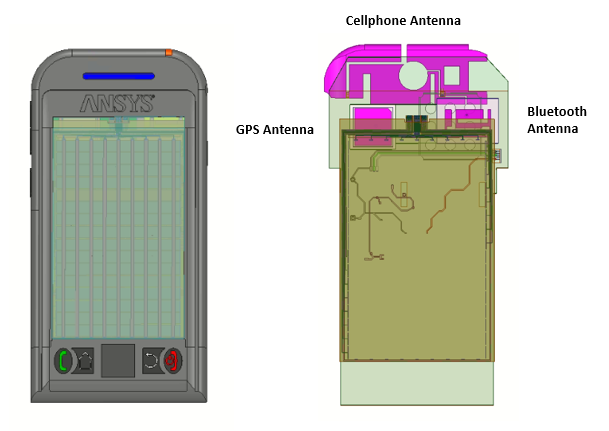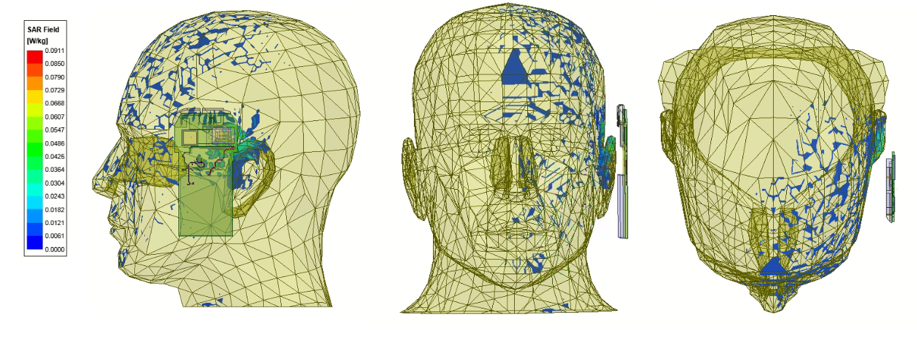ANSYS HFSS offers a way to model SAR distribution!
2020 has been a challenging year for all of us, due to COVID 19 restriction and shelter in place, many engineers had to delay development timelines. ANSYS HFSS offers a great way for all engineers to stay home and work safely. You are able to do all the measurement and testing in house with the simulation tool during the quarantine. LAB TESTING IS NO LONGER YOUR ONLY OPTION.
This article describes using ANSYS HFSS to model cellphone antennas extract the specific absorption rate (SAR) distribution in a human head. Engineers can estimate the SAR values and predict whether it meets the FCC standard. The cell phone antennas included are GPS antenna, Bluetooth/WIFI antenna and cellular antenna.
Overview
According to the Federal Communication Commission (FCC), the specific absorption rate (SAR) is a measure of the heating effect that corresponds to the RF energy absorbed by human body. This is defined as the power absorbed per mass of tissue, with units of watt per kilogram (W/kg). Today, many IoT devices and consumer electronics are using radio frequency (RF) signal for wireless communication. High electromagnetic radiation of the RF signal can lead to heating of the tissue which causes potential health and safety hazards. The FCC has come up with regulations and rules to control the exposure of human to RF radiating energy.
When engineers are designing portable electronics, wearable electronics or other wireless devices, they often times encounter with the following challenges:
Antenna design and performance standalone
Antenna interaction with human body
Antenna communication with other devices
SAR distribution in a human head/body
In the past, going to a testing facility was the only way to do SAR testing. But today, ANSYS offers a way to model SAR for all engineer to do it in house. ANSYS HFSS (high-frequency structure simulator) is a 3D electromagnetic (EM) simulation software for designing and simulating high-frequency electronic products such as antennas, RF or microwave components. Also, HFSS offers a unique Integral Solver (HFSS-IE) that enables users to solve the complex human body structure.
Example
A cell phone model with GPS, cellular, and Bluetooth/WIFI antenna.
Human head and hand model, a SAM phantom IEEE model is created to simulate realistic SAR measurement. The cellphone is placed in between the head and hand with 2mm gap from each.
ANSYS HFSS allows engineers to set up multiple excitations for different antennas, and run at single, multiple, or broadband frequencies at one time. The simulation is going to solve all at once, then engineers can play with excitation and solution frequencies to look at different results at post processing.
In HFSS, when plotting SAR distribution over a geometry, it uses mass density for each material if defined in the material properties. Otherwise (that is, if the mass density for that library material is 0), the density in the SAR Setting dialog will be used.
In the Mass of Tissue box, enter the mass of the material in grams that surrounds each mesh point. The standard values are 1 and 10, corresponding to US or European standards; however, for research purposes you can enter values outside this range.
For the United States and Canada: according to the FCC, the SAR limit is 1.6W/kg averaged over a volume of 1 gram of tissue (FCC Radio Frequency Safety).
For the European standards: according to the EU Parliament, the SAR limit is 2W/kg averaged over a volume of 1 grams of tissue (EU Harmful Mobile Phone Radiation).
Here, we will be showing a few average SAR distribution plots with different antenna on the human head and hand. The plots are showing the SAR effects on 1 gram of tissue, and the readings include both 1g and 10g of tissue.
Example includes: Cellular 1.94GHz, BLE 2.45GHz, WIFI 5GHz, GPS 2.45GHz
Cellular 1.94GHz
The highest average SAR value for the cellular antenna at 1.94GHz when tested with human model is:
SAR(W/kg) for 1g SAR(W/kg) for 10g
Human Hand 0.0724 0.0404
Human Head 0.0754 0.0535
Bluetooth/WIFI 2.45GHz
The highest average SAR value for the BLE/WIFI antenna at 2.45GHz when tested with human model is:
SAR(W/kg) for 1g SAR(W/kg) for 10g
Human Hand 0.0855 0.565
Human Head 0.8038 0.0664
WIFI 5GHz
The highest average SAR value for the WIFI antenna at 5GHz when tested with human model is:
SAR(W/kg) for 1g SAR(W/kg) for 10g
Human Hand 0.0298 0.0168
Human Head 0.0911 0.0088
GPS 2.45GHz
The highest average SAR value for the GPS antenna at 2.45GHz when tested with human model is:
SAR(W/kg) for 1g SAR(W/kg) for 10g
Human Hand 0.0007 0.00059
Human Head 0.00119 0.00054
The readings from the SAR distribution of different antennas meet the FCC SAR limit of 1.6W/kg for the United States and Canada, averaged over a volume of 1 gram of tissue, for the head and hand. They also meet the SAR limit for the EU standard, 2W/kg at average over a volume of 10 gram of tissue.
Summary
ANSYS provides a easy way to model SAR distribution in a human body that is exposed to an electromagnetic field emitted from electronic devices. The solution incorporates the use of the ANSYS HFSS FEM solver, ANSYS Optimetics optimization features and HPC. SAR modeling with the phantom human model can be easily solved and analyzed accurately. Compared with physical measurement testing, SAR modeling using ANSYS tools is much more flexible, as users can virtually analyze any of point on the model. Further work can be performed by using the parametrization feature to extract many different placements of the mobile phone at different location on the head and body.













